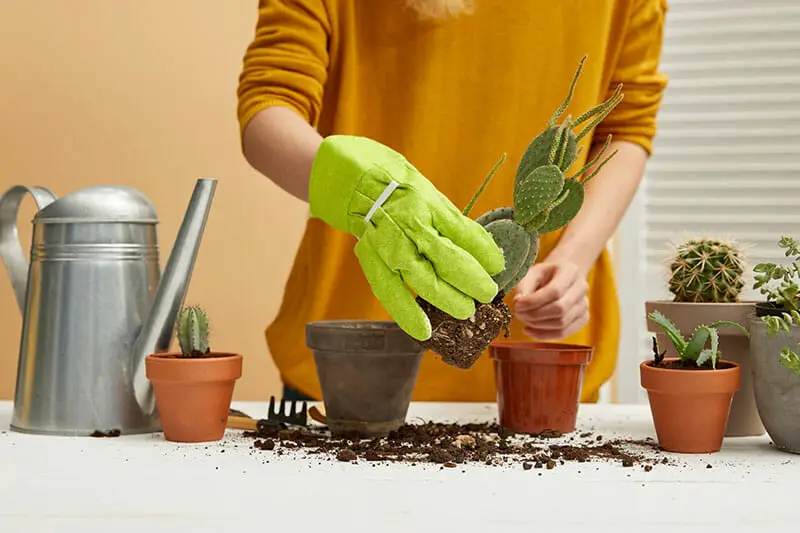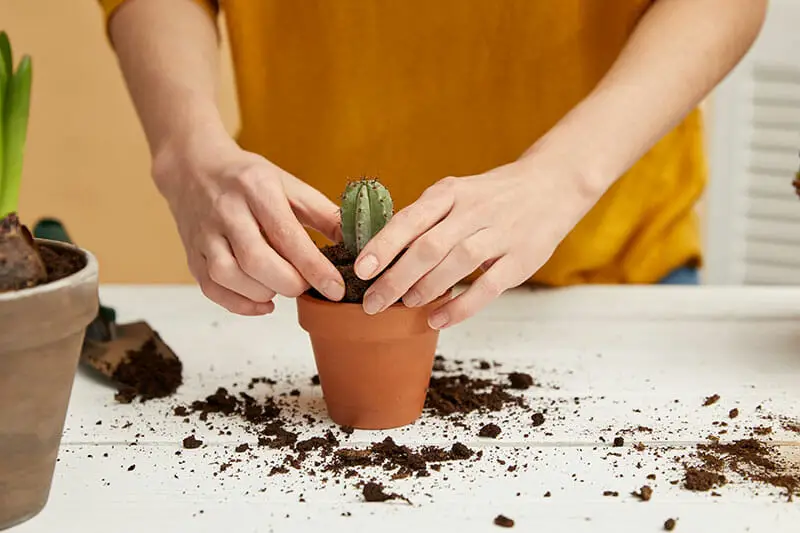You may be wondering if your cactus needs a specific pH range and what steps you can take to regulate it.

What is the ideal ph level for cactus soil?
Cacti typically need a soil with a pH level between 5 and 7 to thrive.
You can regulate pH by testing the soil and water and taking steps to adjust it as necessary. There are several ways to test for pH as well as increase or decrease it as needed to get within the ideal range.
This article will detail the importance of pH levels for cacti as well your options for testing and regulating pH in both your soil and water.
The Importance of pH levels for Cacti
Cacti are acid loving plants which means they like a pH anywhere between 5 and 7.
Each type of cacti has its own desirable range of pH, but most grow best in a pH range of 5 to 6.5.
Before you do anything, you should research your specific type of cactus and what pH it prefers.
The water you are giving your plants can actually change the pH of the soil.
Most places have water that is on the alkaline side, or a very high pH.
Over time this will increase the pH of your soil.
Anything above a pH of 8 can actually prevent the cacti from absorbing the nutrients it needs to grow and stay healthy.
Signs of a pH Imbalance in Cacti

When a cactus has an imbalance of pH it may have signs that might mimic other issues such as sunburn or mites.
There may be yellowing on new growth, areas that are brown and look like they got too much sun, or the plant itself may start to shrivel.
These signs happen because certain elements in the soil become more or less available depending on the pH.
This causes the cactus to not get the right ratios of elements that it needs.
If possible, watering with rainwater is your best option.
Rainwater is naturally acidic and will keep your soil at an optimal pH.
You can also test the pH of your soil and water. Knowing the pH of your water allows you to adjust it as necessary before giving it to your cacti.
Testing the pH of Your Soil
Testing your soil pH is probably the simpler of the two methods. There are products on the market that allow you to test your pH by simply sticking a double probed meter into the soil.
This multifunction soil pH meters not only tell you the pH, but also tell you the moisture levels of the soil and light levels. This is convenient because it will allow you to prevent over and under watering as well as know if your cactus is getting adequate light.

We recommend this affordable 3-in-one measuring kit that lets you measure your soil PH level easily:
- Tests moisture, PH value and light level
- High Accuracy and Rapid Respond
- No battery necessary
Using a Soil pH Moisture Meter
- Step 1: Switch the meter to the setting you are interested in, moisture/pH/light.
- Step 2: Poke the probes between 2-4 inches into the soil.
- Step 3: Move the meter around until the pointer on the dial is slightly bouncing around.
- Step 4: After 10 minutes you can check the pH, moisture, or light levels on the dial.
- Step 5: Remove the meter from the soil and wipe the probes clean. This is important and should be done after every use.
When using your probe meter, make sure you do not force the probes into hard soils.
You don’t want to damage the probes. If your soil is too dry the meter will not work, so you may need to lightly water before testing.
The meter should not be used to test pure water or other liquids. Also, be sure not to leave the meter in the soil for extended periods of time as this could damage it.
Testing Your Water pH
It is a good idea to have both a soil pH meter and a water pH testing kit. You can go about this in two ways.
Use a pH water meter or litmus paper.
A pH water meter will give you more accurate results as it will provide a digital reading. Whereas with litmus paper, you have to compare the color change of the paper to know where about the pH level is.

We recommend this affordable pH tester for a quick reading
- Automatic temperature compensation
- Pocket sized
- Automatic calibration
Using a pH Water Meter
- Step 1: Turn the meter on.
- Step 2: Place the tip of the meter that contains the testing probes into the water.
- Step 3: Wait a few seconds and then take your reading.
Most meters will come pre-calibrated from the factory.
However, recalibration may need to be done after frequent use or if you go a long stretch in between using the meter.
Some meters will come with an initial supply of either calibration liquid or a powder that must be dissolved in water.
When calibrating your meter, it is extremely important to use distilled or deionized water to ensure accuracy. Distilled and deionized water have a neutral pH so it wont effect the readings.
Calibrating A pH Meter
Step 1:
When using the powder form of calibration, there will usually be two different packets of pH powder including 6.68 and 4.00.
Fill two glasses with 250 milliliters each of deionized or distilled water and mix each powder into its own glass.
You will need a third glass of just deionized or distilled water.
Step 2:
After the powder has dissolved completely, you are now ready to calibrate your meter.
First turn the meter on and remove the protective cap that is over the glass probes.
Then place the meter into the 6.68 pH solution and press the calibration button for about three seconds. The reading should be close to 6.86.
Step 3:
Rinse the meter in the glass of plain distilled or deionized water and blot dry with a paper towel.
Then insert the meter into the 4.00 pH solution and hold the calibration button for approximately 3 seconds.
Release the button and the press it one time immediately afterwards. The meter should read 4.00.
Step 4:
Rinse the meter and blot dry. Your meter should now be calibrated and ready for use. You can store the pH solutions for 2 weeks, so they can be reused.
Regulating Your Cactus Soil Acidity

Once you know the pH of your soil and water you can begin to regulate it.
The best way to do this is to test the pH of your water each time before watering. This will ensure that the water given to the plant is in the optimal range and will not change the pH of the soil.
If your pH is too high in the soil you can go about regulating it in a few ways.
You could spread sublimed sulfur over the surface and work it in to the first few inches of soil.
It will slowly leach into the soil and gradually lower your pH.
Lowering Your Soil pH With Aluminum Sulfate
For a more immediate result, you can mix aluminum sulfate into the first inch or so of the soil.
The amount of aluminum sulfate you use will depend on the starting pH level.
It is important to calculate this, because too much can be harmful to your cacti.
A general rule of thumb is to use 1.2 pounds per 10 square feet. There are many different compounds you can use to lower the pH of your soil, the one you choose will depend on your application and personal preferences.
Raising Your Soil pH With Lime
If your pH is too low, you can apply agricultural lime to the first few inches of the soil.
If you need more immediate results you can mix potassium carbonate in the water. It is highly soluble and reaches the root system almost immediately.
Low pH is not as common as high pH.
It is usually a result of over fertilization.
Having a proper fertilization regime is important. You should always test your soil before adding fertilizer to prevent over doing it.
Regulating Your Soil pH Using Water
To regulate and maintain the pH of the soil using water, you should test it water each time before you use it.
This is probably the most efficient way to go about regulating soil pH.
Rainwater has a pH of around 5.1. So, by getting your water to this level you can keep the pH in the soil at optimal levels.
There are quite a few products on the market that allow you to lower the pH of your water, but I find the easiest way to do it is simply use vinegar.
Simply take your initial pH reading, then add a little vinegar at a time and test after each addition until you are around a pH of 5.1. If you add to much you can simply add more water.
Conclusion
Regulating the pH of your soil and water is essential if you want your cacti to grow large and healthy.
Do you have any tips on managing the pH levels of cacti? Please share them in the comments section.